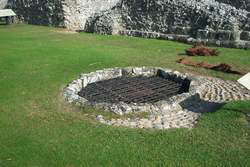Abandoned Communities ..... Old Sarum
By the end of the twelfth century relations between the clergy and the military authorities at Sarum had become more than a little strained. In addition several physical features of the city tended to diminish the quality of life there. Plans were prepared to construct a new cathedral about a mile and a half to the south. The thinking behind the move has been summarised in two of the documents mentioned above. Henry of Avranches wrote that "Old Sarum was like Mount Gilboa: a windy, rainswept place without flowers or birds", "The castle was subject to the laws of Caesar, the city to those of God. The king's followers plundered the clergy", and "There was a shortage of water, and a tiring climb to the top of the hill". According to the 1217 Bull of Pope Honorius III the cathedral church was subject to so many inconveniences that the clergy could not live there without danger to life, the church needed daily repairs from wind and storm, and it was so windy that the canons could hardly hear one another sing. The bare chalk of the hilltop was so bright that several clergymen had gone blind. The military commander's permission was needed to go in or out, and the clergy had to hire dwellings from the soldiers.
On one occasion the dean and clergy of Sarum were returning from a procession to St Martin's church at Milford when they found the East Gate closed. The military authorities refused to admit them, allegedly for security reasons. Soon afterwards Pope Honorius III consented to the move to a new site. Salisbury cathedral was founded in 1220 and largely completed by 1250.
Most of the abandonments described in this website involve communities where the population were reluctant to leave. In the case of Sarum it is likely that the residents of the town were happy to make the move to a new city less than two miles away. There is evidence that some people had already moved even before the Pope's consent had been received. Many of the reasons that swayed the clergymen to wish to leave Old Sarum would have been equally persuasive for the civil population as well. By 1377 only ten poll tax payers remained in Old Sarum, and even in 1422 the borough still had a mayor. But as we have seen, by 1540 no houses were inhabited.
The only right retained by the borough of Old Sarum was the right to elect two Members of Parliament. As a rotten borough it did not lose its electoral significance until the Reform Act of 1832. No one lived there, but the landowner could determine who could stand for election. Often indeed the land would be bought by a wealthy man who had parliamentary ambitions for himself. At election time fictitious burgage plots, accompanied by the right to vote, would be offered on a short lease to people who could be relied upon to cast their vote in favour of the landowner and his nominees. At Old Sarum elections were held beneath an elm tree located, according to the Ordnance Survey map of 1881, on the slope to the south of the main ramparts.
Today the site of Old Sarum is managed by English Heritage. As you might expect, the site is popular for re-enactments. When I was there preparations were being made for a spectacular Viking event. A longhouse had been put up, and the last few sections of thatch were being fastened with a staple gun.
On one occasion the dean and clergy of Sarum were returning from a procession to St Martin's church at Milford when they found the East Gate closed. The military authorities refused to admit them, allegedly for security reasons. Soon afterwards Pope Honorius III consented to the move to a new site. Salisbury cathedral was founded in 1220 and largely completed by 1250.
Most of the abandonments described in this website involve communities where the population were reluctant to leave. In the case of Sarum it is likely that the residents of the town were happy to make the move to a new city less than two miles away. There is evidence that some people had already moved even before the Pope's consent had been received. Many of the reasons that swayed the clergymen to wish to leave Old Sarum would have been equally persuasive for the civil population as well. By 1377 only ten poll tax payers remained in Old Sarum, and even in 1422 the borough still had a mayor. But as we have seen, by 1540 no houses were inhabited.
The only right retained by the borough of Old Sarum was the right to elect two Members of Parliament. As a rotten borough it did not lose its electoral significance until the Reform Act of 1832. No one lived there, but the landowner could determine who could stand for election. Often indeed the land would be bought by a wealthy man who had parliamentary ambitions for himself. At election time fictitious burgage plots, accompanied by the right to vote, would be offered on a short lease to people who could be relied upon to cast their vote in favour of the landowner and his nominees. At Old Sarum elections were held beneath an elm tree located, according to the Ordnance Survey map of 1881, on the slope to the south of the main ramparts.
Today the site of Old Sarum is managed by English Heritage. As you might expect, the site is popular for re-
Three
The main well, not an adequate supply of water for the whole community
Attaching the last few sections of thatch to the Viking longhouse

